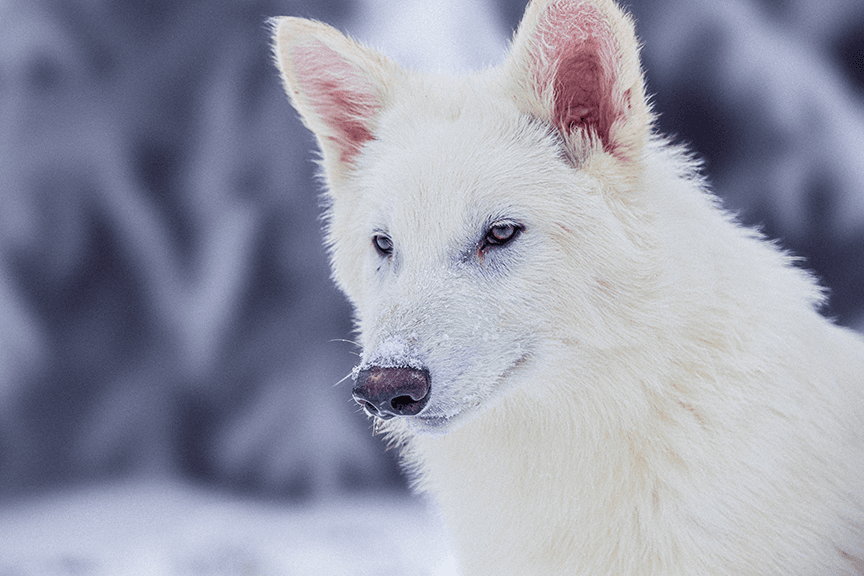In a secret location in the United States, two white wolves are lounging in the grass in a sunny, roughly one-acre enclosure. It’s early spring and a chill wind blows through bare trees nearby. The humans in the enclosure are wearing their winter jackets. With their thick, shaggy fur, the 5-month-old wolves are better adapted to the cold.
One of the humans is Ben Lamm, founder and CEO of Dallas-based startup Colossal Biosciences. He has invited WIRED to be among the first to see the wolves. The animals, he says, are dire wolves, which went extinct more than 10,000 years ago. A large canine species that once roamed the Americas, dire wolves coexisted with other Ice Age megafauna such as saber-toothed cats, giant ground sloths, and woolly mammoths. The company claims it’s the first time an animal has ever been de-extincted.
The wolves, still pups, saunter around the enclosure, unaware that they’re in the wrong time period. The Game of Thrones series popularized the dire wolf as the emblem of the noble and doomed House Stark, and now Colossal claims to have brought it—or at least something that looks like a dire wolf—back to life.
Lamm points out the characteristics that make these animals dire wolves: more pronounced shoulders, a slightly wider head, and thicker haunches than modern-day gray wolves. They’re supposed to have larger jaws, too, but we don’t get close enough to find out. At 5 months, they’re already 80 pounds and are expected to get bigger than gray wolves. And of course, they’re white. Cue Jon Snow.
Lamm, a serial entrepreneur, cofounded Colossal in 2021 to bring back the woolly mammoth, the dodo, and other extinct animals. Sort of. Colossal isn’t directly cloning preserved DNA from prehistoric animals, à la Jurassic Park. Instead, it’s editing the genes of present-day relatives so that they look and act like their extinct predecessors.
Dire wolves Remus (left) and Romulus at 15 days old.Photograph: Colossal Biosciences
“Not only can we identify ancient genes and predict what they do, we can engineer them into cell lines, and we can successfully and healthily create them, and bring them back, which is awesome,” Lamm says once we get inside after viewing the wolves. The company, which recently unveiled a “woolly mouse,” has raised $435 million and says it is now worth $10.2 billion.
Colossal has made three dire wolves so far and plans to make a total of seven or eight, according to Lamm. The wolves that WIRED glimpsed, Romulus and Remus, were born in October. (They’re named after the twin brothers from Roman mythology who were nursed as infants by a she-wolf). A third dire wolf, Khaleesi—a nod to Game of Thrones character Daenerys Targaryen—was born in January.
Colossal’s chief science officer, Beth Shapiro, was on a work trip to the UK when the first dire wolf litter was born. She woke up to the news that the two males had arrived. “I saw the text messages and I was like, ‘I can’t believe I wasn’t awake for this,’” she says. For the birth of Khaleesi, she was there in person. Although the company refers to Romulus and Remus as coming from the same litter, that’s not quite accurate. The two wolves are genetically identical but were carried and birthed by different mothers, Shapiro confirmed over email.
“One of the arguments in favor of working on this is that it brings people to a place of awe,” she says. “The idea that you can see a species we drove to extinction that we now have brought back from extinction can give people a reframing of how we think about the biodiversity crisis.”
Before she joined Colossal as a staff member, Shapiro was a scientific adviser to the company. It was during a company meeting in Dallas while she was an adviser that the idea of bringing back the dire wolf first came up. In 2021 Shapiro had coauthored a paper that attempted to reconstruct the evolutionary history of the wolves by sequencing genomes from five different fossils. At the time, Shapiro was a professor at UC Santa Cruz—a post she still holds alongside her role at Colossal.
For this de-extinction project, Shapiro and her colleagues returned to two dire wolf fossils sequenced in that original paper: A 13,000-year-old tooth from Sheridan Pit, Ohio, and a 72,000-year-old inner ear bone from American Falls, Idaho. The scientists extracted and sequenced the ancient DNA from the two fossils, assembling it into a genome that Shapiro says contains 500 times more data than the previous analysis.
This new analysis might also change our understanding of the dire wolf’s evolutionary history. Scientists previously thought that dire wolves diverged from their shared ancestor with gray wolves around 5.7 million years ago, making the extinct wolves genetically closer to jackals than gray wolves. But the Colossal analysis, Shapiro says, found that dire wolves were the product of interbreeding between two different wolf lineages that took place between 2.5 and 3.5 million years ago. Shapiro says that she and the authors of the original paper are planning to release a new paper that incorporates the new data from the Colossal analysis.
Studying the dire wolf’s genome also allowed the Colossal team to figure out which features distinguished the ancient wolf from its modern relatives. They settled on traits involving size, musculature, hair color, hair texture, hair length, and coat patterning. They then used gene editing to alter the genome of cells from the dire wolf’s closest living relative, the gray wolf. In total the company made 20 unique edits to 14 genes in the gray wolf genome. Of those, 15 were meant to reproduce extinct dire wolf gene variants. Colossal claims it’s a record number of unique genetic edits done to any animal.
But the dire wolf’s genome is still almost identical to that of the gray wolf. This raises a tricky question: Are these wolves really dire wolves or just gene-edited gray wolves? Lamm, of course, says the animals are dire wolves. “We call them dire wolves,” he says. “What’s interesting is that speciation is an area where scientists can’t seem to agree.” A species is often defined by a combination of genetic and physically visible characteristics, including teeth and the shape, size, and color of their body.
George Church, a professor of genetics at Harvard University who cofounded the company with Lamm, says the goal is to eventually produce an animal with the full genome of an extinct dire wolf. “In the meantime, we’re prioritizing all the traits that actually define the species,” he says.
Shapiro, too, says the edits are significant enough to call the new animals dire wolves. “If we can look at this animal and see what it’s doing, and it looks like a dire wolf and acts like a dire wolf, I’m going to call it a dire wolf. And my colleagues who are taxonomists will disagree with me.”
David Jachowski, a professor of conservation at Clemson University in South Carolina, says that there’s “inherently some subjectivity” when it comes to defining species and that the role an animal plays in its ecosystem may be as important as its genetics. There’s also a “tremendous marketing value to wildlife conservation” to declare a species de-extinct, says Jachowski, who did not know specific details about the dire wolf project.
To make the dire wolf, Colossal started with blood drawn from a gray wolf. Working on a type of blood cell called an epithelial progenitor cell, the team edited the DNA so that it more closely matched the genome of the dire wolf. They then took the genetic material from this cell and placed it into the egg cell of a domesticated dog that had had its genetic material removed. Once that egg cell had developed into an embryo, it was implanted into a surrogate dog.
It took eight surrogates and an average of 45 embryos per surrogate to get the dire wolf pups. Two surrogates gave birth to Romulus and Remus, and a third produced Khaleesi. Five of the embryo transfers did not result in successful pregnancies. A second female was born in January alongside Khaleesi, but she died after 10 days from an infection of the intestine.
Hope, an adolescent red wolf from one of the cloned litters produced by Colossal.Photograph: Colossal Biosciences
In a less flashy but perhaps more ecologically significant advance, Colossal says it has used its new cloning technique to produce four red wolves, one of the most critically endangered species in the US. Red wolves were once common throughout the Eastern and South Central US, but intensive predator control programs and habitat loss have decimated their numbers. The species almost went extinct in the 1960s. As of this February, fewer than 20 wild red wolves are left in North Carolina. Approximately 270 are in captive breeding programs across the US with the intention of those animals being reintroduced in the wild.
One of the challenges of rebuilding their numbers is maintaining genetic diversity in the population. All the red wolves alive today, both captive and rewilded, descend from just 12 founder individuals. Genetic diversity gives a species a better chance at survival. It boosts their ability to reproduce and helps them adapt to environmental changes. As a species’ numbers dwindle, so does its genetic diversity. And even if it rebounds, genetic variation doesn’t return.
The red wolves that Colossal cloned include a female and three males from three different founder individuals. Adding those animals to the captive breeding population would increase the number of founding lineages by 25 percent, the company says.
With traditional cloning, researchers take a tissue biopsy, usually from the skin, from an animal they want to copy. They remove the DNA from one of those cells into an egg that has had its own DNA-containing nucleus removed. After developing into an embryo in a test-tube, it’s implanted into the womb of a female surrogate animal. It’s the same technique that was used to create Dolly the sheep.
Instead of a tissue sample, Colossal’s new method relies on a blood draw. The company isolated expandable endothelial progenitor cells from the blood of red wolves to make their clones. Matt James, chief animal officer at Colossal, says this less-invasive technique means less recovery time for the animal being cloned. Using blood cells is also theoretically a quicker and easier way of securing the genetic material for cloning.
“It opens up more pathways for biobanking, and biobanking is probably our best insurance policy against extinction,” says James. “Right now, we need to begin banking as much biodiversity as we can as we face this massive biodiversity crisis. Now we have another tool in the toolkit for that.”
The company is in talks with both the US Department of the Interior and the North Carolina government about the potential introduction of the cloned red wolves into the wild.
The three dire wolves are now living in a 2,000-acre secure ecologic preserve, which is in a different location than the small enclosure that WIRED visited. Shapiro says that Colossal is not considering rewilding the dire wolves. “We want to use this project to bring attention to the plight of gray wolves who really need our help and support right now, and thinking about what predators can do on a landscape.”
Wolf reintroduction does have a cascade of ecological benefits—wolves regulate deer and elk populations to prevent overgrazing, allowing other native plant and animal species to flourish. But the dire wolves Colossal created won’t be doing any hunting of their own. They’re fed a mix of kibble and meat from beef, horse, and deer daily.
One of Colossal’s main arguments for de-extinction has been that de-extinct species can perform the same role in an ecosystem as their extinct ancestors, potentially restoring that ecosystem back to a more balanced state. “One of the things I worry about as a wildlife conservationist is focusing on species that may be glitzy but are of a potentially low impact in terms of helping restore ecosystems,” says Jachowski.
Lamm is aware that the dire wolves his company created are glitzy. That’s the point. “I think that the pop culture aspects of the dire wolf will be sexy and fun for a lot of people, and I think that will drive awareness for wolf conservation,” he says. Which goes to show why the question of whether Colossal’s animals are dire wolves may be moot. They are wolves, altered at the genetic level by man for his own purposes—something new, and very, very old.




